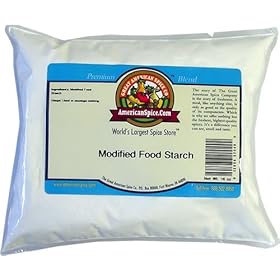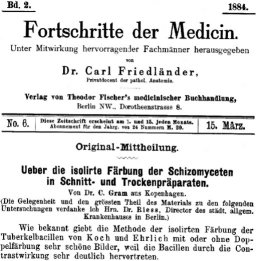Dr. Joseph over on the “(It’s a…) Micro World (…after all)” blog posted a list of his ten favorite microbes. After showing up in the comments of his post and being a wiseass about E.coli and Gram staining, the least I can do is participate here. Besides, it’s a great idea. Therefore here are ten of my current favorite microbes:
Category: Methods
“How To Do Stuff”
Double-Ewe Tea Eff: “Modified Food Starch”
 One of my projects is to appease one of my weaknesses. As I’ve probably mentioned before, “Gluttony” is my second-most-favorite deadly sin. If you’ve been listening to “Stir-Fried Random” (new episode coming shortly, I promise) and reading the blog recently, you can probably tell that among my large collection of “a peculiar fondess for [whatever]” attributes that I possess is one for “Cinnamon Bears“. While they’re not too bad as far as candy goes, they’re still not good for me. Plus, like any candy they can get to be kind of expensive. (Dear Amazon.com: The package plainly says “2/$100“. You’re selling these in groups of 12. Now, I only carried my calculation out to 3 significant figures, but I estimate that this should cost $6.00. Not “$6.85”. Plus $7.90 for shipping. $14.75 for $6.00 worth of convenience-store candy is just stupid.)
One of my projects is to appease one of my weaknesses. As I’ve probably mentioned before, “Gluttony” is my second-most-favorite deadly sin. If you’ve been listening to “Stir-Fried Random” (new episode coming shortly, I promise) and reading the blog recently, you can probably tell that among my large collection of “a peculiar fondess for [whatever]” attributes that I possess is one for “Cinnamon Bears“. While they’re not too bad as far as candy goes, they’re still not good for me. Plus, like any candy they can get to be kind of expensive. (Dear Amazon.com: The package plainly says “2/$100“. You’re selling these in groups of 12. Now, I only carried my calculation out to 3 significant figures, but I estimate that this should cost $6.00. Not “$6.85”. Plus $7.90 for shipping. $14.75 for $6.00 worth of convenience-store candy is just stupid.)
Anyway…I’ve gotten my grubby paws on a small bag of erythritol, which is effectively a calorie-free sugar alcohol produced from a regular sugar by a natural fermentation process. All I should need is one or more thickening agents and some oil of cassia and/or other flavors and I should be able to come up with a recipe for my own pig-out-all-I-want, even-better-than-mass-market cinnamon bears. Food is one of the few areas that I seem to have any natural artistic talent with, so I ought to be able to handle this.
 The trick is going to be getting the right texture. I’ve found recipes online that use gelatin or pectin. The store-bought product, though, uses “Modified Food Starch”. How exactly do they “modify” the food starch? I vaguely recalled that it was an acid-treatment process that partially breaks up the long glucose polymers, but I wasn’t sure. As any modern nerd would do, I decided to ask My Friend, The Internet.
The trick is going to be getting the right texture. I’ve found recipes online that use gelatin or pectin. The store-bought product, though, uses “Modified Food Starch”. How exactly do they “modify” the food starch? I vaguely recalled that it was an acid-treatment process that partially breaks up the long glucose polymers, but I wasn’t sure. As any modern nerd would do, I decided to ask My Friend, The Internet.
Most places seem to be vague about what exactly the “modification” is, but it became quickly obvious that there were multiple treatments that result in “Modified Food Starch”. Ah, but I was in luck! The Food and Drug Administration actually has a specific entry[1] in the Code of Federal Regulations, which can always be counted on to definitive. So, I went and looked at good old Title 21, Volume 3 of the Code of Federal Regulations and…WTF?!?!?
They list a bewildering array of chemical and enzymatic treatments that all get lumped into “Modified Food Starch” (or “Food Starch-modified” as they quaintly put it).
I guess my happy new box of “Corn Starch” will have to remain unmodified for the time being. At least until I can figure out how to produce my own ?-amylase [without spitting, that is]. I also have unflavored gelatin and pectin at my disposal here, so I’ll come up with something.
Anybody got a good reference on industrial food processes?…
[1] 21CFR172.892
“On the lactic fermentation and its bearings on pathology.”
Lunchtime – time to get this posted…(Let me know if this page is loading way too slowly…)
For this month’s “Giant’s Shoulders” I offer you mouthwash and yogurt.
Indirectly, at least.
Continue reading “On the lactic fermentation and its bearings on pathology.”
Stir-Fried Random: Alferbeetagama!
(Update 20081104T1050: added a minimal embedded flash-based player at the bottom of the post, if you’re willing to settle for mp3 quality and want to listen from your web browser…)
(Update again 20081126: I wish I had realized before that the stupid thing was autoplaying despite explicitly including “autoplay=false” in the parameters. I’ve removed the embedded player again until I find a way to prevent autoplaying. Sorry about anyone that was annoyed by this.)
I was going to post this last night, but there appears to have been another bout of database connection errors again at my ISP (“host blocked due to too many connection errors”). I’m guessing either someone is DOS’ing the database server or one of the other users had some very badly behaved custom code running. They’ve got it fixed now, so here we go…
 After staying up too (insert profanity here) late again despite having to get up extra-early this morning to vote before work…here’s the first real episode of Stir-Fried Random. Still only about 10 minutes long – I’d like to make it longer, but it’ll still probably take a few episodes of building up to it. An actual shiny new <audio> tag is included for those with bleeding-edge browsers that support it (let me know if it works – hypothetically the 3.1 Beeta[sic] version of Firefox and I believe the most recent Opera support this.). Otherwise, direct-download is available below the show notes:
After staying up too (insert profanity here) late again despite having to get up extra-early this morning to vote before work…here’s the first real episode of Stir-Fried Random. Still only about 10 minutes long – I’d like to make it longer, but it’ll still probably take a few episodes of building up to it. An actual shiny new <audio> tag is included for those with bleeding-edge browsers that support it (let me know if it works – hypothetically the 3.1 Beeta[sic] version of Firefox and I believe the most recent Opera support this.). Otherwise, direct-download is available below the show notes:
Continue reading Stir-Fried Random: Alferbeetagama!
Yeast needs to breathe
 As readers may have guessed from previous posts, my brewing interests are minimally conventional. Fortunately, the Basic Brewing Radio podcast seems to regularly expand well beyond the usual “fermented malt flavored with a tisane of hops” thing (I need to try to make my own “Ginger Beer Plant” from scratch one of these days…). A couple of weeks ago, they did an episode covering an experiment on aeration methods which was very interesting. It does my ego good to know that I correctly guessed how the results would turn out. You can get a copy of the nice write-up of the experiment itself here, but here’s the simple version:
As readers may have guessed from previous posts, my brewing interests are minimally conventional. Fortunately, the Basic Brewing Radio podcast seems to regularly expand well beyond the usual “fermented malt flavored with a tisane of hops” thing (I need to try to make my own “Ginger Beer Plant” from scratch one of these days…). A couple of weeks ago, they did an episode covering an experiment on aeration methods which was very interesting. It does my ego good to know that I correctly guessed how the results would turn out. You can get a copy of the nice write-up of the experiment itself here, but here’s the simple version:
Aqua-pedestrianism and Ice Cream Yeast
 Today’s batch of blog-based Stir-Fried Random includes another interactive map of a lake-spanking expedition, a very brief musing on search engines, and a return to “intentional food microbiology” discussion. To preview: you can get pizza without ever getting out of the water on Lake Conroe, “spanking” is amusingly popular for search engines, and no, there is not normally any yeast in ice cream, but perhaps there could be. Read on, please…
Today’s batch of blog-based Stir-Fried Random includes another interactive map of a lake-spanking expedition, a very brief musing on search engines, and a return to “intentional food microbiology” discussion. To preview: you can get pizza without ever getting out of the water on Lake Conroe, “spanking” is amusingly popular for search engines, and no, there is not normally any yeast in ice cream, but perhaps there could be. Read on, please…
FoodTV’s new “Food Detectives” show…
 That’s all I can stands, I can’t stands no more! I had intended to try to come up with another post for this month’s “The Giant’s Shoulders” anthology, but I’ve just encountered such an appalling concentration of disappointing un-science that I cannot restrain myself any further. Guess I’ll have to settle for one post in the anthology this month.
That’s all I can stands, I can’t stands no more! I had intended to try to come up with another post for this month’s “The Giant’s Shoulders” anthology, but I’ve just encountered such an appalling concentration of disappointing un-science that I cannot restrain myself any further. Guess I’ll have to settle for one post in the anthology this month.
FoodTV’s new “Food Detectives” show sounded so promising. I thought to myself “‘MythBusters’ meets ‘Good Eats’!?!? That would be pure, refined, pharmaceutical-grade WIN!” Then I saw their premier episode. The “experiments” appeared blatantly and badly staged, and in some cases shockingly badly designed. For example, their “experiment” with refrigerator deodorants involved showing a guy sticking his face into a ‘fridge allegedly full of smelly stuff and filming him making faces while they timed how long he pretended to be willing to keep his face in there.
“Ueber die isolirte Faerbung der Schizomyceten in Schnitt- und Trockenpraeparaten”
 The Giant’s Shoulders blog carnival is coming up in two days, and I just realized I still haven’t gotten a post up for it yet. So, here it is.
The Giant’s Shoulders blog carnival is coming up in two days, and I just realized I still haven’t gotten a post up for it yet. So, here it is.
I put up some quick reviews of several classic microbiology-methods papers for the previous edition of this blog carnival, but didn’t actually get around to putting up the one for what is almost certainly the most well-known microbiology technique: “The Gram Stain”. So, this post is about it:
Gram HC: “Ueber die isolirte Faerbung der Schizomyceten in Schnitt- und Trockenpraeparaten”; Fortschritte der Medicin; 1884; vol 2, pp 185-189
That’s “Regarding the Isolational(?) Coloring of Schizomycetes in Cut- [i.e. tissue sections] and Dried Preparations” in “Medical Progress”. The translation hosted by the American Society for Microbiology uses the word “Differential” where I’ve put “Isolational” – which is probably not quite right either but it’ll have to do for now – but I’ll get to that in a moment.
If you’ve ever been exposed to microbiology labwork before, you’ve almost certainly done or at least watched a procedure referred to as a “Gram stain”. In brief, you smear your sample with bacteria on a glass slide and bake it on, then you dump some purple stuff on it, them some brown stuff, then you rinse it briefly with alcohol, then you dump on some pink stuff, and then rinse it in water and look at it under a microscope. Bacteria that stay the original dark purple-blue color of the original purple/brown stuff are considered “Gram Positive”, and those that don’t instead appear the pink color of the last stain, and are considered “Gram Negative”. Many textbook authors and microbiology instructors will breathlessly proclaim that the Gram Stain reveals two “fundamental” categories of bacteria, but I’ll spare you my rant about that.
Properly speaking, this isn’t actually Gram’s stain, as described in his original paper. The modern variations that we’re all taught in microbiology class were developed later, and I believe they are nowadays based mainly on Victor Burke’s 1922 paper on the subject[1].
Regarding the title of the paper: “schizomycete” is what they used to call most kinds of bacteria. “Mycete” meaning “fungus”, as bacteria were assumed to be “plants without chlorophyll” just like molds and mushrooms, and “Schizo-” meaning “split in two”, since bacteria reproduce by splitting into two cells rather than by producing spores like “other” fungi. I say “most” because things like cyanobacteria (“blue-green algae”) or Green Sulfur Bacteria would have been referred to as “Schizophyta” (“fission-plants”). What Gram was originally trying to do wasn’t to differentiate one kind of bacteria from another, either, but to make it easy to tell bacteria from from the nuclei of cells in bacteria-infected tissue.
For that matter, Gram was really metaphorically standing on the shoulders of Koch and Erhlich, as he was building on their technique for staining “tubercle bacteria” – that is, tuberculosis-causing members of the genus Mycobacterium. Gram mentions that you need to stain this type of bacteria for the “usual” 12-24 hours to make this work, incidentally, as opposed to a few minutes for other “schizomycetes”. This suggests that you are expected to have some idea of what you’re going to find before you use the stain, as opposed to the modern implementation which is supposed to tell you something about what kind of bacteria you’re finding.
Still, Gram does report that some bacteria take the stain and some don’t, giving us a preview of the “differential” character of the modern version. He specifically notes typhoid and some causes of bronchial pneumonia fail to hold the stain. Given that Typhoid Fever is caused by a strain of the “Gram-negative” butt-bacter Salmonella enterica, and there are a number of “Gram negative” bacteria as well as “Gram positive” that can cause pneumonia, this makes sense. He also does mention the use of Bismarck Brown R a.k.a. Vesuvine as a counterstain in order to make the nuclei of the infected cells brown in contrast to the dark blue of the infectious bacteria in the tissue.
For much of the century-and-a-quarter since Gram’s publication, the question of why the Gram stain works was thoroughly investigated, and even today I occasionally hear or read assertions to the effect that the Gram Stain isn’t well understood. I disagree with this just as I think its importance to bacterial identification is grossly overblown, and if you want to know why, I have a previous post all about why the Gram stain works and how we know. You may or may not also be interested in an older post regarding whether or not “acid-fast” bacteria like the ones that cause tuberculosis (which don’t stain at all when using the modern version of the Gram stain) are “Gram Positive” or not. As always, if you spot any errors or have any questions, please let me know…
[1] Burke V: “Notes on the Gram Stain with Description of a New Method.” J Bacteriol. 1922 Mar;7(2):159-82.
Mountain Dew® Wine: Disappointment strikes!
<whine excuse=”obligatory”>Have I ever mentioned what a huge hassle it is to relocate from one abode to another 1600 miles away?…</whine>
 I’m finally back at House v1.0 where I can check on the progress of my Mountain Dew® Wine. It appears to have managed to ferment, in spite of the severe dose of preservatives in the stuff designed to prevent that from happening. It went somewhat slowly, but it’s gone from an original gravity of around 1.054 down to about 1.011 or so, suggesting about, say, 5-6% alcohol in the final product, which has faded to a pale, cloudy yellow color. Hopefully the cloudiness is from still-living yeast, which has now demonstrated that it is reasonably benzoic-acid-and-caffeine tolerant.
I’m finally back at House v1.0 where I can check on the progress of my Mountain Dew® Wine. It appears to have managed to ferment, in spite of the severe dose of preservatives in the stuff designed to prevent that from happening. It went somewhat slowly, but it’s gone from an original gravity of around 1.054 down to about 1.011 or so, suggesting about, say, 5-6% alcohol in the final product, which has faded to a pale, cloudy yellow color. Hopefully the cloudiness is from still-living yeast, which has now demonstrated that it is reasonably benzoic-acid-and-caffeine tolerant.
I fear I must report that the result is a crushing disappointment to me. It’s not very good. Worse yet, it’s not very bad, either. I was hoping that if it wasn’t surprisingly tasty that it would at least be shockingly awful in some interesting way so I’d have something entertaining to say about it here.
Actually, the adjective that comes to mind is “inoffensive”. If you would like to whip up a quick simulation of what I’ve got here, you might be able to do it like this: Take some citrus-flavored sparkling mineral water. Dilute it about half with (uncarbonated) distilled water. Then mix about 7 volumes of that with one volume of vodka. What I’ve got here is slightly sparkling, with a barely noticeable citrus flavor and little or no remaining sweetness. It’s a little surprising to me just how much of the flavor of Mountain Dew® apparently comes from its sweetness. Perhaps next time I try this (if there ever IS a “next time”…) I’ll have to mix regular and “diet” Mountain Dew® – with some bonus sugar to make up the difference, of course.
I’m not completely done here. I’m still going to dispense it into cleaned bottles with a little bit of sugar to prime it for full carbonation. Sanitized plastic soda-bottles of course – none of that snobby glass stuff for this here experimental drinkin’ substance! It may be high-class for “pruno”, but it’s sure as heck not Champagne™. (Besides, I want to evaluate reusing plastic bottles anyway – it’d be a lot easier to tell when there’s too much pressure and to let some of the pressure off if there is.) Plus, I need to take some of the still-live yeast and keep it alive. No point in developing a benzoic-acid-tolerant yeast strain and not keeping it!
On a related note, an article was mentioned on fark.com, saying that back in 1955, a scientist “proved” that it is not normally possible to get drunk on beer. Of course, he seems to have been referring to dilute mass-market bladderwash and his reasoning was that a typical human stomach cannot contain enough 3.7%-alcohol beer for a typical human to achieve a dangerous blood-alcohol level.
As usual, the articles (see here and here) go for the “a scientist says this” part but never bother to say WHERE the scientist says it – usually a real scientific publication.
A quick search of pubmed turns up a likely candidate:
Greenberg LA: “The definition of an intoxicating beverage.” Q J Stud Alcohol. 1955 Jun;16(2):316-25 (link goes to the pubmed entry, which has little more information that this).
I do believe it is a moral imperative that I get a copy of this article somewhere so that I may reference it later. Is there anyone out there reading this who might be able to get a copy of this paper somewhere for me? Please?…
“Antibiotic Susceptibility Testing by a Standardized Single-Disk Method”
Okay, one last post in the Classic Science Papers challenge before my time’s up:
Bauer AW, Kirby WM, Sherris JC, Turck M :”Antibiotic susceptibility testing by a standardized single disk method.” Am J Clin Pathol. 1966 Apr;45(4):493-6.
![Plates showing that Hops extract [like in beer] does inhibit certain kinds of bacteria Petri dishes containing bacteria, showing inhibition of growth by certain substances](http://www.bigroom.org/images/hops_plates.jpg) The “Kirby-Bauer” antibiotic susceptibility test is another standard method that you should cover in microbiology class. The method involves getting a pure culture of the bacteria you want to treat, and then growing it in a petri dish. By putting paper disks soaked with various anti-bacterial substances, you can identify which ones are most effective at killing (or at least stopping) the bacteria in question – for example if you’re trying to figure out what kind of antibiotic to give to the guy coughing up some unknown plague in your doctor’s office… The anti-bacterial substance that the paper is soaked in slowly diffuses into the area around it on the petri dish, getting more dilute the further it gets from the paper. You can then estimate how powerfully anti-bacterial the stuff is by how far from the paper the bacteria stop growing.
The “Kirby-Bauer” antibiotic susceptibility test is another standard method that you should cover in microbiology class. The method involves getting a pure culture of the bacteria you want to treat, and then growing it in a petri dish. By putting paper disks soaked with various anti-bacterial substances, you can identify which ones are most effective at killing (or at least stopping) the bacteria in question – for example if you’re trying to figure out what kind of antibiotic to give to the guy coughing up some unknown plague in your doctor’s office… The anti-bacterial substance that the paper is soaked in slowly diffuses into the area around it on the petri dish, getting more dilute the further it gets from the paper. You can then estimate how powerfully anti-bacterial the stuff is by how far from the paper the bacteria stop growing.
The authors here didn’t invent this trick. Not all antibiotic-susceptibility tests are “Kirby-Bauer” tests (the blurry picture there is of an experiment I did involving the beer ingredient hops, and is not a Kirby-Bauer test. Click the picture to go to my “Beer Cures Anthrax” post from long ago…). What this paper describes is a method that finally standardized this test. Instead of having to use multiple paper disks with different amounts of the same substance, the “Kirby-Bauer” test prescribes specific concentrations of each antibiotic, and specific nutrient agar formulations, and so forth, so that determining which antibiotic your mystery bug is best treated with can be done in a way that gives consistent results regardless of who is performing the test.
The method is regularly updated to account for new antibiotics, but is still referred to as the “Kirby-Bauer” antibiotic susceptibility test to this day. Incidentally, the American Society for Microbiology kindly hosts a reprint of this paper as a .pdf file, so you can read it yourself if you’d like.
(UPDATE 20110328: new URL for the reprint of the paper. Thanks, Alex S!)